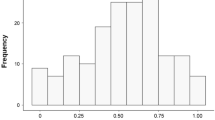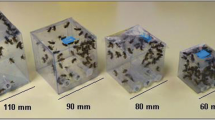Abstract
-
1.
In each of four replicate experiments we fed three groups of bee-eater chicks for 24 h on different diets: bees, dragonflies, and a mixture of the two.
-
2.
Dry weight assimilation efficiency did not differ between treatments and was in the region of 40–50%. Caloric assimilation efficiency was about 60% and did not differ significantly between diets.
-
3.
Mean Growth efficiency (wt. gain/intake) was highest in all four replicates in chicks fed on the mixed diet.
-
4.
When metabolic requirements are taken into account, growth efficiency on the mixed diet varies less with variation in intake than on the two pure diets.
-
5.
The advantage of feeding chicks on a mixed diet may partly explain why parents do not show exclusive preferences for energy-maximising prey types.
Similar content being viewed by others
References
Al Jaborae FF (1979) The influence of diet on the gut morphology of the Starling (Sturnus vulgaris L. 1758) D. Phil thesis, Oxford
Belovsky G (1978) Diet optimisation in a generalist herbivore: the moose. Theoret Pop Biol 14:105–134
Drodz A (1967) Food preference, food digestibility and the natural food supply of small rodents. In: Petrusewicz K (ed) Secondary productrivity of terrestrial ecosystems, vol 1. Polish Acad Sci, Warsaw, pp 323–330
Dunn EH (1975a) Caloric intake of nestling double-crested cormorants. Auk 92:553–565
Dunn EH (1975b) Growth, body components and energy contents of nestling double-crested cormorants. Condor 77:431–438
Freeland WS, Janzen DH (1974) Strategies in herbivory by mammals: the role of plant secondary compounds. Am Natur 108:269–289
Gibb J (1957) Food requirements and other observations on captive tits. Bird Study 4:207–215
Goss-Custard J (1977) The energetics of prey selection by redshank Tringa totana (L.), in relation to prey density. J Anim Ecol 46:1–19
Greenstone MH (1979) Spider feeding behaviour optimises dietary essential amino acid composition. Nature 282:501–503
Hudson PJ (1983) The variation and synchronisation of daily weight increments of Puffin chicks Fratercula arctica. Ibis 125:557–561
Kale HW II (1965) Ecology and bioenergetics of the large-billed marsh wren Telmatodytes palustris in Georgia salt marshes. Publ Nuttall Ornith Club 5:1–142
Kleiber M (1975) The fire of life. 2nd edition. Kriege Publishing Co, Huntington N.Y., p 234
Kluijver HN (1933) Bijdrage tot de biologie en de ecologie van de spreeaw (Sturnus vulgaris vulgaris L.) gedurende ziju voortpalantingstijd. Pub Plantenzieklenk Dienst Wageningen
Krebs JR, Avery MI (1985) Central-place foraging in a single-prey loader: the European Bee Eater Merops apiaster. L. J Anim Ecol (in press)
Krebs JR, McCleery R (1984) Optimisation in behavioural ecology. In: Krebs JR, Davies NB (eds) Behavioural Ecology: an evolutionary approach. Oxford, Blackwells Scientific Publications, pp. 91–121
Krebs JR, Stephens DW, Sutherland WJ (1983) Perspectives in optimal foraging. In: Brush AH and Clark GA Jr (eds) Perspectives in Ornithology. Cambridge: Cambridge University Press, pp 165–216
Lessells CM, Stephens DW (1983) Central place foraging: singleprey loaders again. Anim Behav 31:238–243
Melnyk RB, Boshes M (1980) Efficiency of food utilization during body weight gain in Dormice (Glis glis). Physiol Behav 24:1017–1021
Owen-Smith N, Novellie P (1982) What should a clever ungulate eat? Am Natur 119:151–178
Rapport DJ (1980) Optimal foraging for complementary resources. Am Natur 116:324–346
Royama T (1970) Factors affecting the hunting behaviour and selection of food by the great tit Parus major L. J Anim Ecol 39:619–668
Tinbergen JM (1981) Foraging decisions in Starlings (Sturnus vulgaris L.). Ardea 69:1–67
Westerterp K (1973) Energy budget of the nestling starling Sturnus vulgaris, a field study. Ardea 61:137–158
Zimmerman JL (1965) Bioenergetics of the dickcissel Spiza americana. Physiol Zool 38:370–389
Author information
Authors and Affiliations
Rights and permissions
About this article
Cite this article
Krebs, J.R., Avery, M.I. Chick growth and prey quality in the European Bee-eater (Merops apiaster). Oecologia 64, 363–368 (1984). https://doi.org/10.1007/BF00379134
Received:
Issue Date:
DOI: https://doi.org/10.1007/BF00379134




